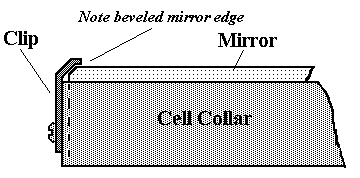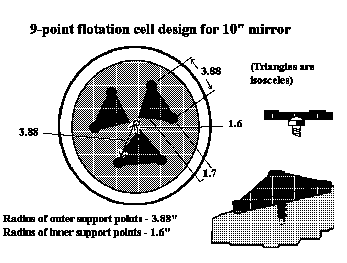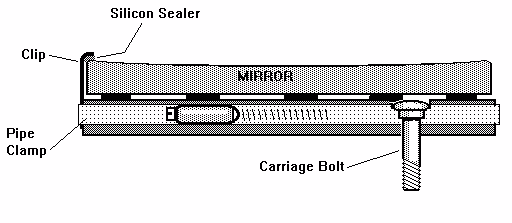Caressing Your Mirror
Jack Kramer
The cell that holds the mirror in your telescope is one of the least visible components. Because of that, we tend not to think very much about it, except during the process of building or upgrading a telescope. But just as each component plays a part in providing good images in your scope, the cell is critical. Especially with a Newtonian, you use it on a regular basis to re-collimate the mirror system.
Not only is it important to have a cell that's easy to adjust during collimation, but the cell must also hold your mirror with just the right amount of tension. It must truly caress the mirror! The cell must not induce a warping effect on the mirror nor should it hold the mirror so tightly that it affects the figure. Mirrors, especially the thinner, light-weight ones, are not as rock-hard as they appear. Jeff Inman encountered this problem some years ago when he found that the images in his scope could not quite be brought to a good focus. It turned out that the answer was simply to loosen the clips that hold the mirror in the cell. Once this was done, the images turned sharp again. The clips had induced a very slight strain on the mirror, which was just enough to distort the surface figure. With accuracy of mirrors measured in waves of light, it doesn't take much to affect the surface. In fact, I've heard it said that the mirror should be held so gently that it can be moved about in the cell without loosening the clips. The down side is that the scope may have to be re-collimated more frequently. Even if you don't intend to build a telescope, it's good to keep this in mind so when you re-install the mirror of your commercially-made telescope after a cleaning, you don't induce a stress by over-tightening the clips.
The Clips That Hold The Mirror
The purpose of the clips is simply to keep the mirror from falling out of the cell. The edges of the clips should not interfere with the light path by intruding too far onto the surface of the mirror. Typically, what little pressure they exert is against the beveled front edge of the mirror. On most commercially-made cells, the clips are screwed to the collar that holds the circumference of the mirror.
Flotation Cells
In a floatation cell, the mirror is supported at the back of the cell by triangular-shaped plates. Each plate has three pads on which the mirror rests. The typical is a 9-point flotation cell where there are three plates. Larger mirrors often employ an 18-point flotation, using six triangular plates. By being free to pivot, the plates conform to the orientation of the mirror as it rests (or "floats") on them. This minimizes stress or bending torsion on the mirror. The plates themselves can be balanced on "dome nuts" or supported by a post that's spring loaded into a hole on the inside back surface of the cell. (These two ways of mounting the plates are shown in the following illustration.) The IMPAC program in the club's software library includes a feature where you can input the parameters that apply to your mirror, then see a diagram of the proper flotation cell arrangement. The following diagram was adapted from IMPAC.
The flotation design is similar to other types of cells in that clips hold the mirror in the cell and the base of the cell has three screws for collimation.
Variations
While flotation cells are commonly used on Newtonian telescopes, there are some alternative designs. I have had very good luck with some variations on the "normal" cell. For one thing, the clips that hold my mirror are held in place with a large pipe clamp. They're clamped to the circular wooden backplate on which the mirror rests; this plate is slightly larger than the 10" mirror to prevent the clips from pressing tightly against the side of the mirror. A dab of silicon sealer under each clip cushions the force with which the clip presses against the edge of the mirror. There are eight clips evenly spaced around the circumference. The clips are not secured anywhere, but must be re-inserted under the pipe clamp each time the mirror is reinstalled after removal from the cell. This holds the mirror very securely, yet without inducing any perceptible distortion. The following is a diagram of this arrangement of clips.
Instead of resting on flotation pads, the back of the mirror rests on thirty rubber pads glued to the backplate. These are the type of adhesive-backed rubber squares (each about 1"x1") commonly used as anti-skid pads under the bases of electronic equipment. As an alternative, some telescope makers have used a large piece of cork as a cushion between the mirror and backplate.
The Sling-Type Cell
The situation in a Dobsonian telescope is a bit different than in other designs, because a "Dob" moves through a relatively small arc in altitude - from horizontal to straight overhead. The mirror thus isn't turned every which way during observation. While one of the other cell designs would be usable in a Dobsonian, many telescope makers opt for a sling-type mirror mount. This has the virtue of simplicity, plus it handles thin mirrors very gently. The following diagram shows the essential features of a sling-type cell.
The mirror is supported by a sling made of heavy canvas-type strapping, though the best material is an old automobile seat belt. This material is flexible, yet it hardly stretches. Plastic webbing of the type used in lawn furniture is unsatisfactory because it stretches so much that it's impossible to keep the optical system collimated. The mirror is held in place by three pins that bear against the edge of the mirror, spaced 120o apart with one pin at top center. These pins have tabs that keep the mirror from falling away from the cell. (For illustration purposes in the diagram, the tabs are shown larger than they should really be.) The pins are generally made as eccentrics, with an off-center hole, so they can be rotated to bear more or less tightly against the mirror edge. The eccentrics and the bolts that hold the strap are mounted to a backplate like on the other cells. In a sling arrangement, the back of the mirror may rest on 9 or 18 point flotation pads, on rubber cushions, cork, or similar backing. (The backplate has been omitted from the diagram for the sake of simplicity.) The three-point adjustments can be the same as with other cell designs. An alternative is to have the collimation bolts connected to the flotation pads. On Grant Barlow's 18-point flotation (based on the Dave Kriege design), there are six triangles, joined into three pairs with a metal rod between them. The bolts bear against these three rods. In an effort to keep costs to a minimum, the mirrors in some Dobsonian telescopes on the market are mounted in cells of the utmost simplicity. The mirrors are held onto the backplate with a long strip of duct tape wrapped several times around the edge of the mirror. On their 171/2" mirrors, Coulter also uses large pipe clamps over the tape. Coulter uses no backing for the mirror; it simply rests directly against a piece of wood or particle board. Others use silicon sealer as a backing. In some cases, the three adjustment screws bear directly against the back of the board. Surprisingly, this minimalist approach does work, though it's not easy to remove the mirror for cleaning, nor is it easy to collimate the scope.
The Collimating Screws
The three screws that are used to adjust the mirror during collimation require a "stop" of some sort to hold the mirror in the collimated position. Many commercial telescopes come with two sets of three screws. One set moves the back of the cell for collimation. The other set bears against the back of the cell. This second set is first loosened, then tightened once collimation is completed. I prefer spring-mounted screws as shown in the following diagram.
The springs eliminate the bother of adjusting two sets of screws. If these springs are sufficiently stiff, they'll hold the mirror in position well enough so that it seldom goes out of collimation. Most commercially-made cells sold as separate components use this design. Choose the cell design that meets your needs...but make sure the finished product caresses your mirror securely, but ever so tenderly.
Published in the November 1994 issue of the NightTimes




